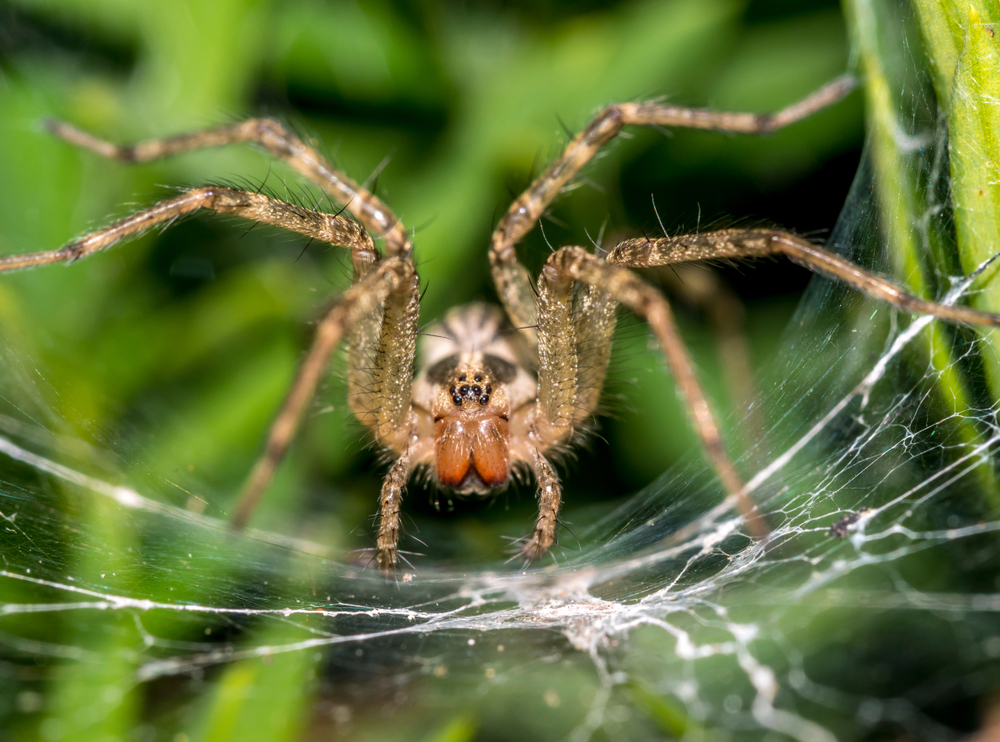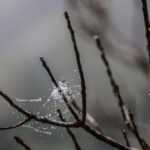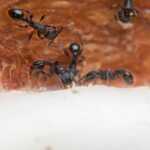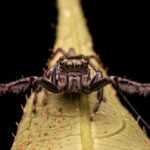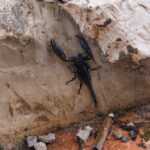The Remarkable World of the Barn Funnel Weaver Spider
The barn funnel weaver is a spider known for its funnel-shaped web. Wondering if it’s dangerous and how to identify it? This article explains what you need to know about this common arachnid.
- The barn funnel weaver spider, or Tegenaria domestica, displays distinct size, coloration, and web-building habits, making it easily recognizable.
- This spider thrives in both indoor and outdoor environments, commonly inhabiting human-built structures and various sheltered areas, showcasing its adaptability and widespread presence.
- Barn funnel weaver spiders generally do not act aggressively toward humans and pose low medical risk from their bites, highlighting their ecological role without significant threat.
Identification and Characteristics of Barn Funnel Weaver Spiders
The barn funnel weaver spider, scientifically known as the species Tegenaria domestica, exhibits specific physical traits that make identification straightforward. It belongs to several distinct species within its genus, and researchers recently separated the Giant House Spider into three distinct species. Female barn funnel weaver spiders measure between 7.5 and 11.5 millimeters in body length, averaging around 9 to 10 millimeters, while males typically range from 6 to 9 millimeters. The female body length averages about 9 to 10 millimeters, while the male body length averages around 7 to 8 millimeters. This species averages about 10 millimeters from head to abdomen, making it smaller than some other Tegenaria species, such as the Giant House Spider, but larger than many smaller species within the genus.
One of the most striking features of the barn funnel weaver spider is its coloration. Adult T. domestica are typically dark orange to brown or beige. The abdomen often displays a pinkish to pale flesh color with gray to black patches. The cephalothorax—the front part of the spider’s body—shows a red-brown color with pale-yellow hairs and two pale-gray longitudinal lines. These distinctive markings help distinguish the species from other spiders. The spider also features dark stripes running along its head and abdomen, and dull, black, longitudinal stripes on the cephalothorax, which serve as key identification markers.
Physical Traits and Sexual Dimorphism
The barn funnel weaver spider has elongated bodies and a straight abdomen, especially noticeable in males, which helps differentiate it from other species. Its legs appear proportionally shorter compared to other spiders and display a vague annulated pattern. These striped legs add to the spider’s distinctive appearance. Males have longer, more agile legs and an elongated abdomen compared to females. Furthermore, the cephalothorax shows a dark pattern that may appear faded, adding to the spider’s identifiable traits. The spider sits at the back of its funnel-shaped web, remaining still and alert as it waits for prey.
In summary, you can identify the barn funnel weaver spider by its size, color patterns, elongated bodies, straight abdomen, and distinctive leg markings. These characteristics, along with its preference for building funnel-shaped webs, make it a unique and easily recognizable species within the spider community.
For authoritative taxonomic and distribution information on Tegenaria domestica, consult the Natural History Museum Bern and the World Spider Catalog.
Habitat and Distribution
The barn funnel weaver spider, also known as the domestic house spider, inhabits a diverse range of environments, making it one of the most adaptable spiders in its family. Native to Europe, this spider has successfully established populations across North America as well. Its global distribution encompasses Europe, North Africa, the Middle East, and Central Asia, demonstrating its adaptability to various climates. The species inhabits regions as far north as Scandinavia and as far south as North Africa or the southernmost parts of its range. The domestic house spider also appears in the checklist of Danish spider species.
These spiders commonly occupy human-made structures, particularly sheds and barns, which provide ideal environments for their funnel-shaped webs. They prefer to construct their webs in a corner or sheltered area, including cracks in walls and under various outdoor objects, where they remain undisturbed and have easy access to prey. Females often select a suitable sheltered area such as attics, basements, or storage rooms for overwintering and reproduction. In places like Colorado, people frequently encounter barn funnel weaver spiders indoors, making them one of the most common indoor spiders. Females that dwell indoors typically live for over one to two years, with some surviving up to seven years in such environments.
Their ability to adapt to both indoor and outdoor environments contributes to the barn funnel weaver spider’s widespread presence. Whether in a dark corner of a barn or a hidden crack in a wall, these spiders thrive in areas that offer shelter and food, ensuring their survival and proliferation across diverse regions.
Behavior and Web Mechanisms
The barn funnel weaver spider builds intricate webs and exhibits unique behavioral traits. It constructs a funnel-like structure by spinning stressed silk threads over a flat surface, often in a corner or protected spot. These spiders create a classic funnel-shaped web, featuring numerous taut silk threads radiating from the central funnel. The web features a funnel like structure reaching back into a corner or sheltered area, with the spider sitting at the back of the funnel shape. This web structure not only serves as a marvel of natural engineering but also provides a crucial tool for the spider’s survival. Males and females sometimes exhibit strictly behavioral differences.
The barn funnel weaver spider uses its web to detect movement, sensing disturbances that indicate the presence of prey. The web consists of stressed silk threads spun over flat surfaces that transmit vibrations to the spider. When an unsuspecting insect disrupts the web’s silk threads, disturbed vibrations travel through the web and alert the spider. The spider responds to these vibrations by rapidly retreating deeper into the funnel, demonstrating its defensive behavior when threatened.
When the spider detects prey, it rushes out from the funnel tip to capture it with remarkable speed and precision. It does not follow a continuous gait pattern, but instead moves in short intervals with pauses. Barn funnel weavers act as agile hunters, relying on both their vision and web vibrations to detect prey. This efficient predatory behavior ensures the spider’s sustenance and highlights the sophisticated nature of its web mechanisms.
Life Cycle and Reproduction
The barn funnel weaver spider progresses through a fascinating life cycle from egg to adulthood, marked by specific reproductive habits and seasonal patterns. Domestica spiders hatch from egg sacs, with the young emerging and developing rapidly. The life cycle young typically involves growth from hatching to maturity within a year. The egg sac plays a crucial role in protecting the developing spiderlings and is an essential part of the reproductive process. Females produce multiple egg sacs throughout their lifespan. The mating season occurs from May through July, with male numbers peak in June and July, indicating mating typically occurs during these months. Male activity increases as they seek females for reproduction.
Egg Sacs and Female Longevity
Females produce multiple egg sacs, often more than nine, which they suspend above the web using silk lines for support. These egg sacs provide a safe environment for the developing spiderlings.
Females that live indoors tend to survive longer, with reports of domestica females living up to seven years in rarely disturbed, sheltered environments such as attics or basements. Domestica females reportedly surviving as long as seven years in protected indoor environments. Females regularly survive through winter and may live several years in the same web, especially in protected or undisturbed locations. Compared to most spiders, the barn funnel weaver’s lifespan and reproductive habits stand out for the longevity of females and their ability to persist in stable indoor habitats.
Interaction with Humans
Barn funnel weaver spiders generally avoid confrontation with humans and do not behave aggressively. T. domestica is not a particularly aggressive species and tends to retreat when disturbed. When disturbed, the spider instinctively retreats to its web, a nearby object, or hides behind another nearby object for safety. The spider may also huddle against an other nearby object or curl into a tight ball against a nearby surface when threatened. The spider’s web environment is a key part of its defensive response, providing shelter and a place to retreat. These spiders rarely bite unless provoked, so interactions with people usually remain uneventful. They prefer to escape rather than engage in aggression, unlike some other aggressive species.
In rare cases when a bite occurs, it usually happens because the spider feels provoked or trapped. Even then, the bite rarely penetrates the skin, and no cases have reported barn funnel weaver bites causing significant harm. Their presence represents more of a nuisance than a threat; indeed, Tegenaria species rarely bite.
To safely remove these spiders from homes, use a container and its container lid to guide the spider inside, then release it outdoors. This method protects both the spider and the homeowner while allowing the spider to continue its ecological role.
Medical Importance
Barn funnel weaver spider bites have low medical significance. Bites may cause mild pain, swelling, and redness, similar to those from grass spiders. These symptoms remain manageable and pose no serious health threat.
Barn funnel weavers do not exhibit aggressive behavior, which further reduces bite risk. Overall, their bites have minimal medical importance, and basic first aid can treat any symptoms, ensuring these spiders do not present a significant health hazard.
Defense Mechanisms and Predators
Barn funnel weaver spiders protect themselves through various defense mechanisms. They remain stationary and hidden in their webs until prey arrives, minimizing their visibility to predators and relying on the spider’s retreat to avoid threats. The spider’s reflex actions when disturbed include quickly darting into the funnel or adopting a defensive posture to protect themselves from perceived threats.
When disturbed, barn funnel weavers usually escape rather than fight, relying on the spider’s retreat into their funnel-shaped webs for safety. If their web is partially destroyed, the spider’s defensive mechanism may involve retreating deeper into the funnel or curling into a tight ball against a nearby surface.
These defense strategies help barn funnel weaver spiders survive in environments filled with natural predators.
Professional Pest Control Solutions
Managing spider populations, including common house spiders such as barn funnel weavers, often requires professional pest control services. When handling barn funnel weavers, professionals recommend using a container to gently capture and relocate them rather than direct contact. This humane and effective method ensures the safety of both the spider and homeowner.
The barn funnel weaver spider is a remarkable species with unique characteristics and behaviors. From its distinctive physical traits to its intricate web mechanisms, this spider exemplifies the fascinating complexity of arachnids. Its adaptability to various habitats and non-aggressive nature make it a common yet harmless presence in human environments.
Understanding their life cycle, interactions with humans, and medical importance helps demystify their ecological role. Professional pest control solutions, such as those offered by Las Vegas Pest Control, provide effective ways to manage their populations safely and humanely, ensuring harmonious coexistence.
Frequently Asked Questions
Are funnel weaver spiders poisonous?
Funnel weaver spiders do not pose a poisoning risk to humans; their venom is harmless, and they play a beneficial role in insect control.
How venomous are funnel weavers?
Funnel weaver spiders generally pose no danger to humans, as their venom is not harmful. However, it is wise to exercise caution due to the potential for bites, especially from male funnel weavers. Overall, treat them with care, as they help control insect populations.
Where are barn funnel weavers found?
Barn funnel weavers inhabit most of the United States, often residing in sheds, barns, and door crevices, as well as outdoor environments like hollowed trees and caves. They commonly appear near buildings and natural shelters.
What are the distinctive features of the barn funnel weaver spider?
You can identify the barn funnel weaver spider by its pinkish to pale flesh-colored abdomen with gray to black patches, red-brown cephalothorax adorned with pale-yellow hairs, and shorter legs that display a vague annulated pattern. These features collectively help distinguish this unique species.
How do barn funnel weaver spiders capture their prey?
Barn funnel weaver spiders capture prey by constructing funnel-shaped webs with taut silk threads. When these threads vibrate, the spider senses the disturbance and swiftly ambushes its prey.
